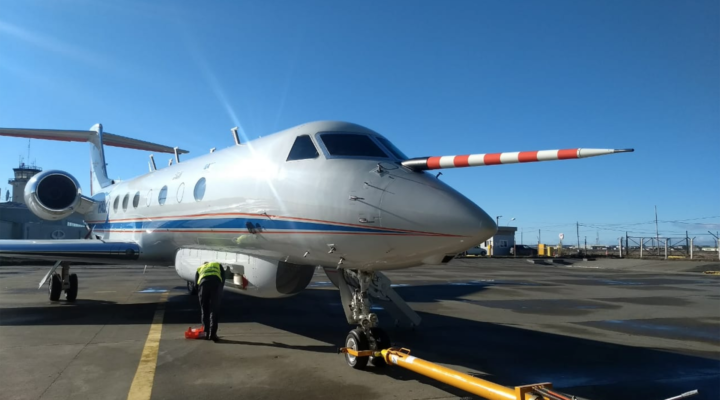SOUTHTRAC PROJECT
Scientists launch an unprecented project to study the atmosphere
They will use cutting edge devices to measure unknown dynamic and chemical aspects of the vertical structure of the atmosphere, between the south of Argentina and Antarctic Peninsula.
The project Transport and Composition of the Southern Hemisphere Upper Troposphere and Lower Stratosphere (SOUTHTRAC), aims at learning diverse aspects of the vertical structure of the atmospheric processes in the southern hemisphere, that is, from their closest layers to the terrestrial surface up to more than an altitude of 90 kilometers
The project will take place in the south of Argentina and will have its operational bases in Río Grande (Tierra del Fuego) and El calafate (Santa Cruz). The researcher team comprises scientists who belong to CONICET; ‘Austral University’; ‘National Technological University’ and ‘National University of Cuyo’; and the National Weather Service of Argentina. Besides, there are dozens of specialists from Germany, universities of Chile and the ‘Chilean Antarctic Institute’. Five German institutions will cooperate: Deutsches Zentrum für Luft- und Raumfahrt (Munich), Forschungszentrum Jülich, Karlsruhe Institute of Technology, Mainz University and Frankfurt University.
The experiment is unique because the measurements of the dynamic as well as chemical processes of the atmosphere will be conducted from the soil, from satellites and -in situ- from a German aeroplane GULFSTREAM G550. The plane has been equipped with cutting edge devices and there will be crossed flights from the South of Patagonia, on the Andes and on the Antarctic Peninsula. Besides, it is going to have two STEMME S-10 gliders equipped with measurement instrumentation on board, and capable of operating long-haul flights at great height and downwind of the Argentine sector of the Andes mountain range.
This task is relevant because it is the first time that the dynamic and chemical aspects of the atmosphere in the south of Patagonia and the Antarctic Peninsula are studied thoroughly.
Atmosphere dynamics
The first stage of the project will be carried out this year between September and October and will focus on the dynamic aspects of the atmospheric activity, linked to the behavior of the gravity waves. Experts know that those waves have great impact on the general circulation of the atmosphere, on the accurate determination of weather forecast, and on the turbulence that affects air navigation. This task will be conducted with the participation of CONICET researchers who belong to the Atmospheric Dynamics Research Team of the ‘Faculty of Engineering of the Austral University’ led by Alejandro de la Torre, principal researcher of the Council.
“As it happens with the seawater, the atmosphere, far from being at rest, it is constantly disturbed. We study these disturbances or atmospheric waves, which are responsible for the vertical transport of energy and the amount of movement, in order to better understand and predict the behavior of the atmosphere on a global scale,” de la Torre explains.
The region where the measurements will be taken was chosen because it is an area of the atmosphere in which there is a huge activity of gravity waves, which, paradoxically, very little experimental data is currently available.
“The selected area is also relevant because it coincides with the information of the Antarctic polar vortex, an element of the circulation of the atmosphere whose dynamics has almost never been measured but has great global importance. In Argentina, this data will help us to learn the cold air raids. In addition, it will be possible to infer how the Antarctic polar vortex works,” says Rodrigo Hierro, CONICET associate researcher and member of the team led by de la Torre.
“The global models of atmospheric circulation that are used to provide the forecast do not consider the influence of gravity waves. To be able to include them, in addition to allowing better predictions about the weather, will make possible to obtain real time information on possible turbulences of the atmosphere at heights that affect air navigation,” explains de la Torre, whose team has worked on several occasions on the analysis of atmospheric data with foreign institutions, some of which are part of this study.
Chemistry and atmospheric composition
The second phase of this project will be conducted this year between November and December and will be focused on the study of the chemical processes and chemical composition of the atmosphere. This part of the research will involve two different projects in which CONICET researchers at the Mendoza region of the ‘National Technological University’ (UTN) will participate.
One of the projects will be in charge of Enrique Puliafito, independent researcher of the Council, and will focus on obtaining on-site aerial information of contaminants and aerosols linked to biomass burning, which have potential effects on precipitation, the properties of clouds and radiative balance.
Furthermoe, during the second part, CONICET associate researcher Rafael Pedro Fernández will be responsible for a project that will aim at evaluating the impact that VSL- type Halogens have on the destruction of stratospheric ozone at the periphery of the Antarctic polar vortex, where due to low temperatures, the existence of ice crystals and the high levels of radiation, there is an increment of the heterogeneous recycling chemistry that catalytically destroys ozone.
To read the latest news of the first stage of the project, click here.
By Miguel Faigón
Translation: Cintia González
